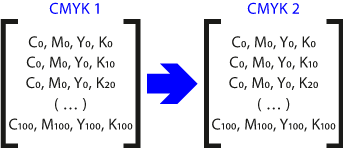DeviceLink profiles are special colour profiles that encapsulate a conversion between the colour spaces of two devices (hence the name).
This kind of profile, oriented to colour conversions in printing, allows things as repurposing for another system files prepared for one type of printing (with the consequent changes of inks, paper, etc.), or reducing the maximum ink usage of jobs already in CMYK, etc.
Warning: DeviceLink profiles do not describe conversions from CMYK to CMYK only, although this is the commonest kind. They may also describe conversions from or into other colour spaces, such as RGB. In addition the conversion chain may include more than one profile (although that's unusual). The only restrain is that the profiles involved at the start and end of the of the conversion chain must be what the ICC calls device profiles: input "("scnr"), display ("mntr") or output ("prtr").
The conversions included in a DeviceLink profile are tweaked by adding prepress parameters that cannot be included in normal profiles. They are stored in a colour matching table "AToB0" (or "A2B0", where "A" is the first device and "B" is the second device).

The quality and accuracy of the matching depends on the size of the table and the quality of the software used to create it. The table is a matrix of point whose size is chosen when creating the profile. So, for example, if we were to create a profile with an 11 × 11 dot matrix, the colour channel values would be 11 (representing 10% increments of each colorant). As the CMYK channels are four, the profile table lines would be 14.641 (that is: 11 × 11 × 11 × 11 × 11).
As the connecting colour space (PCS) a DeviceLink profile uses the colour space of the second profile in the chain. This table describes and applies a unique rendering intent (chosen when creating the profile).
DeviceLink profiles are only used for conversion purposes and cannot be embedded in or assigned to images, PDF or other files with colour data (it would be meaningless).
Why they exist: The trouble of standard colour profiles
Colourimetric accuracy in colour conversions with standard colour profiles has the undesirable side effect of losing some needed prepress adjutsments and parameters (for example: black-only ink breaks into mixes of four CMYK inks).

The main reason for this is that, when converting from CMYK to CMYK with normal profiles, the input values must pass through the Profile Connection Space (PCS), which is always a colour space such as CIELAB or CIE XYZ 1931). This means that each CMYK value quartet is converted into a triad (Lab or XYZ) and then becomes a quartet again.

In contrast, as mentioned above, DeviceLink profiles consist of a straight conversion table between the source and destination colour spaces. This avoids, among other things, passing through a PCS of three values per colour. This means that non-colourimetric prepress values can be retained. For example, the purity of the colorants can be kept (meaning CMYK pure black stays "0/0/0/100"), the Total Area Coverage (TAC) of ink, the way black generation is done, etc.
Pros and cons
- Cons: Their creation requires highly specialised software in the hands of experienced operators, so their price is not cheap (some are protected against uncontrolled use). Besides, they lack flexibility (they are blocked colour conversions), so each specific need requires building a different profile. Lastly, they are not supported by all graphic arts devices and software (although their use is becoming more and more widespread).
- Pros: They can perform quickly and accurately colour conversion tasks that would not be possible otherwise. This alone makes them very cost-effective in commercial printing environments.
DeviceLink profiles in PitStop
PitStop includes in the installation of its latest version 53 DeviceLink profiles in two groups (one for CMYK-CMYK conversions between standardised devices and another for TAC reduction). These profiles are protected against their use in another software, even if it is installed in the same system running PitStop.
Besides, PitStop can use any other manufacturer's profiles as long as they comply with ICC standards.
[© Gustavo Sánchez Muñoz, 2025] Gustavo Sánchez Muñoz (also identified as Gusgsm) is the author of the content of this page. Its graphic and written content can be shared, copied and redistributed in whole or in part without the express permission of its author with the only condition that it cannot be used for directly commercial purposes (that is: It cannot be resold, but it can form part as reasonable quotations in commercial works) and the legal terms of any derivative works must be the same as those expressed in this statement. The citation of the source with reference to this site and its author is not mandatory, although it is always appreciated.